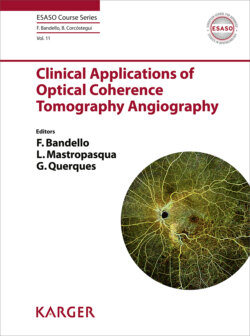Читать книгу Clinical Applications of Optical Coherence Tomography Angiography - Группа авторов - Страница 26
На сайте Литреса книга снята с продажи.
Current Limitations and Future Direction of OCTA for Choroidal Melanoma and Radiation Retinopathy
ОглавлениеDespite advances provided by OCTA in the differentiation of choroidal melanoma and pseudomelanomas, and particularly in our understanding of radiation retinopathy, certain limitations still exist. First, OCTA is very dependent on image quality and the limitation of image artifacts [43–45]. Say et al. [45] described image artifacts in eyes after irradiation for uveal melanoma. They showed that low signal strength and artifacts contribute negatively towards the analysis of OCTA images, and both were more frequent in eyes with poor vision after irradiation [45]. Furthermore, artifacts can result in misinterpretation, such as loss of focus leading to reduction in CVD, and RPE atrophy masquerading as neovascularization [45, 47]. Hence, it is important that standardization of techniques in image acquisition, and guidelines to maintain good image quality and minimize artifacts should be provided in any study on OCTA [45]. Second, current machines do not allow scan depths allowing full visualization of melanomas beyond a thickness of 3.0 mm with resulting scans showing multiple artifacts [41, 42, 45]. These scans do not provide sufficient data to allow an accurate generation of overlying retinal microvasculature, more so intratumoral microvasculature [45, 46]. Thus, OCTA currently only allows the differentiation of tumors through their remote indirect effects in the macular region [36, 37, 60]. Third, there is currently no normative databases for OCTA-acquired FAZ, CVD, and FD measurements. Consequently, most OCTA studies described here report changes relative to fellow eyes [34–37, 40, 59]. There are also variations in measurement of CVD and FD, with the majority of techniques requiring extraction of OCTA images, not raw data, from each machine and post-acquisition image processing with third-party software subject to errors and inconsistencies [38–40, 53, 56, 57]. Furthermore, among currently available OCTA machines, only the Optovue Avanti has proprietary, investigational software to automatically quantify FAZ and CVD using raw data, and even so, values cannot be compared outside the same machine [80]. Even with the above limitations, continued evolution in OCT technology in the form of swept-source OCT may have potential in greater scan depth, faster scans with fewer artifacts, a wider field of view, and improved analysis of OCTA metrics [79, 81, 82]. Also, software upgrades revealing new image capture algorithms and image averaging in OCTA may also result in better quality from less noise and less discontinuous vessel segments [83, 84]. Finally, as OCTA gains momentum as an indispensable imaging modality, the eventual generation of a normative database may not be far-fetched.
In conclusion, OCTA provides additional features that can help differentiate between choroidal melanomas and pseudomelanomas. However, its role in ocular oncology is probably more suited for the early recognition and management of radiation retinopathy. OCTA is not a means to replace IVFA but rather should be used in conjunction, as it provides a fast, efficient, non-invasive, and dyeless method for the visualization of retinal microvasculature, without the ability for a wide scan depth or demonstrating leakage.
